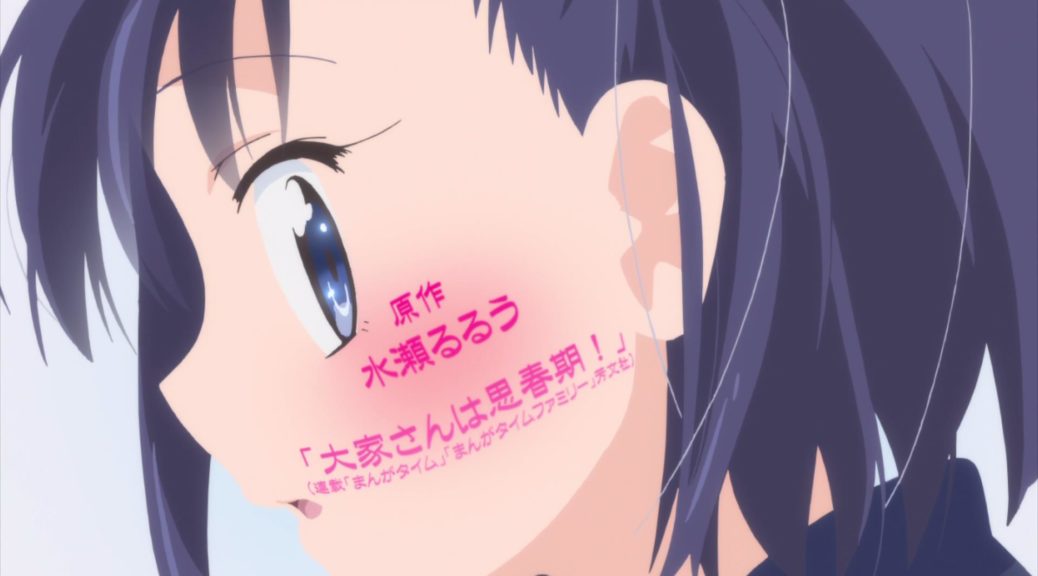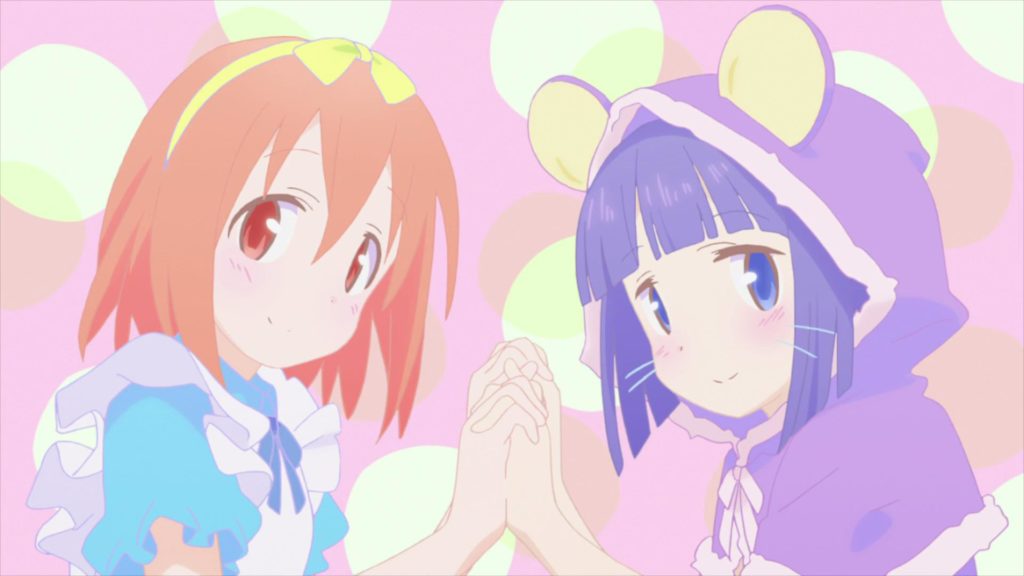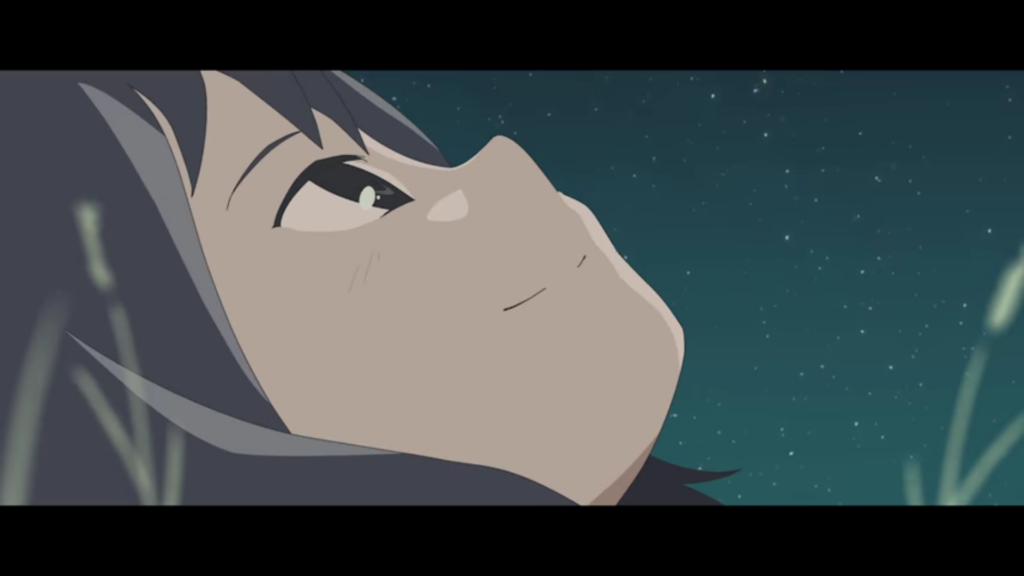
Shorts as a Creative Venue – Part 2
Last time we took a look at how the history of short anime, which had been rather unremarkable up until this point despite some interesting exceptions, encountered a paradigm shift in 2013 that lead to the proliferation to many auteur-led projects and the embracement of digital-focused animation, which was still seen as relatively unconventional at the time. We also completely skipped over Yama no Susume, another integral factor to this new era and arguably the most crucial part of the story overall, so obviously that means we’ll be focusing on it in this post, right?
Well, not quite.
As important as Yamasusu is to both myself and this story, we’re not quite ready to discuss it just yet. Instead, let’s skip ahead for now, to a chapter where its influence was likely felt the strongest: winter 2016. A season where most people’s attention was focused on titles like ERASED and Grimgar of Fantasy and Ash, the latter being Ryousuke Nakamura and Mieko Hosoi’s first foray into a full-length TV anime that we mentioned last time. As interesting as those shows were from both a directional and visual standpoint though, they’re not the season’s main stars in relation to this post; that role was taken up by Mahou Shoujo Nante Mouiidesukara (Mahoii) and Ooya-san wa Shishunki!.
Both airing in the same season could be seen as something of a callback to 2013’s events, but the major difference here was in the new trend they aimed to set; pushing solely for new visual flair wasn’t a necessity at this point, as shows like Robot Girls Z and Hackadoll had already proven the intent for others to carry on the legacy established by the big three mentioned in the previous post. Instead, they opted to take Muromi-san’s idea of incorporating young talent into the mix and run with it, effectively creating a win-win environment where the younger generations of animators within the industry could trade off the strain and pressure of full-length production for the opportunity to take up more high-profile roles. In the case of these two shows, the main areas that stood out in terms of the people attached to them were the character designers/chief animation directors and those who provided key animationKey Animation (原画, genga): These artists draw the pivotal moments within the animation, basically defining the motion without actually completing the cut. The anime industry is known for allowing these individual artists lots of room to express their own style. to both, so let’s take a look at who these people were.
I mentioned that Yamasusu’s influence was probably felt the most in this season, and Kazuaki Shimada’s role as character designer for Mahoii is the reason for that. Shimada started his career at Dogakobo during 2009, and found himself being juggled between the company’s subcontracted works and their own productions as an in-betweener – standard fare for most animators. His career proceeded rather steadily after his key animationKey Animation (原画, genga): These artists draw the pivotal moments within the animation, basically defining the motion without actually completing the cut. The anime industry is known for allowing these individual artists lots of room to express their own style. debut a year later, but things got a bit more interesting in 2012 when he found himself working on a number of YuruYuri S2 episodes along with none other than Yuusuke Matsuo – the man affectionately known as Fugo – whom you may have seen on this blog before.
There’s no doubt that fate was at work here, because Shimada bailed from Dogakobo almost immediately after his work on YuruYuri was done, only to pop up as one of the core staff members on Fugo’s Yamasusu. He drifted from place to place after work on that was done, but ultimately returned to Fugo’s side for both Yamasusu’s second season and to help him out on the hell known as The iDOLM@STER Cinderella Girls’ production. His abilities were clearly valued by Fugo, and Shimada’s own loyalty to Fugo makes the entire situation feel like something of a mentor/disciple relationship, so it’s no surprise that Shimada would soon follow in Fugo’s footsteps by stepping up as character designer for Mahoii – the biggest difference being the contrast in age and experience when they went ahead with their pet projects.
It’s also no surprise that said designs would feel heavily inspired by his mentor’s considering how closely he’d been working with them at that stage, but that wasn’t the only similarity shared between Mahoii and Yamasusu; Shimada also made it a point to bring along many of the youngsters who had worked with them on the latter, essentially creating a project largely dominated by fresh talent. Some bigger names did find themselves involved with it too however, as the master of colours Kotomi Deai came along to deliver a lovely OP, while Fugo himself also appeared briefly despite still being busy with Dereani because, well, why wouldn’t you help out your loveable disciple?
Mahoii never did quite reach the same heights as Yamasusu in the end, but that was never the main concern in the first place here; it’s a project where the younger generations got to shine, spearheaded by someone with a mere five or so years of experience at the time. Not too shabby.
Atsuki Shimizu’s road to becoming character designer for Ooya-san isn’t quite as poetic a story as Shimada’s, but it’s an impressive one nonetheless. He wasted no time in showing his promise as a Yoshinari-inspired action/effects animator immediately after bursting onto the scene at the turn of the decade, and well, he basically just continued down that path of pumping out notable work wherever he turned up. His name is probably synonymous with Tokyo Ghoul these days, considering it’s the one project where he stuck around to do a considerable amount of work at the time.
Which no doubt made it all the more surprising for people when they found out that his first time taking up a key role would be as character designer/chief animation director on a cute little short, as opposed to working towards the opportunity to be part of some high profile action show. Occurrences like this are yet another reason the world of shorts can be so interesting, as we get to see some people favour the chance to try out higher responsibility with something new as opposed to sticking with what’s tried and true, though I’d be lying if I called this an entirely new venture for him; he’d already proven that his arsenal extended beyond action and effects animation beforehand, and even had some experience working with shorts – most notably when his solo work ended up being the visual highlight of the entirety of Puchimas.
One can’t say for sure what’s next in store for Shimizu considering he seems to have returned to his hit and run style he was fond of before Tokyo Ghoul, but you wouldn’t be faulted for expecting great things, to say the least.
It wouldn’t be fair to talk about Shimada and Shimizu while leaving out any mention of the other youngsters who helped shape each show, but let’s revisit a point made last time before doing so, about how staff scaling exponentially in full-length anime is one of the main reasons shorts can sidestep production madness. We talked about Teekyuu and Ai Mai Mi previously, but the reality is that Mahoii and Ooya-san are far more relevant examples simply due to saner staff lineups. The directors weren’t handling absolutely everything on their own here, so roles were split up as one would normally expect. The major difference from your standard full-length production came from the key animationKey Animation (原画, genga): These artists draw the pivotal moments within the animation, basically defining the motion without actually completing the cut. The anime industry is known for allowing these individual artists lots of room to express their own style. side, as the majority of each show’s episodes were solo efforts; both ran for twelve episodes each, nine of which were solo for Mahoii, and ten for Ooya-san.
Episodes being worked on solo like this helps streamline the entire production process significantly, from allowing production runners the luxury of keeping tabs on a smaller number of people to the animation director(s) simply having less work on their plate, amongst many other things. This means less scheduling issues and constraints, which in turn promotes a healthier work environment and affords room for the creators involved to take more chances and experiment. The experiment this time around was in allowing a significant portion of the newest generation of animators to step up and try their hand at most of these episodes, and judging by the results, it’s safe to say things went well.
A few names which stood out the most include Noriyuki Imaoka, whose loose art feels reminiscent of Toshifumi Akai’s at times, as well as Satoshi Furuhashi, who seems to have enjoyed playing around with effects whenever given the opportunity. Then we have Takumi Sunakohara (20 y/o), a Yoshinari follower whose effects are an interesting combination of both Yoshinari and webgen sensibilities, not to mention Nonoshi’s (ノノ志) amusing smears and packing sound effects away gag. Finally, we have China (ちな), whose Ooya-san episode included a number of fun visual quirks such as smears/ghost hands and slyly inserting names into impact frames, not to mention some lovely and detailed art at points. Clearly that wasn’t enough for him though, as he made sure to show up on Mahoii as well, specifically on the day he celebrated his 20th birthday. Talk about making the most of an opportunity!
The concept of allowing youngsters the opportunity to take on key roles isn’t a revolutionary one by any means – we did just talk about Tatsuya Yoshihara previously, after all – but the creation of a space where that can happen on a consistent basis can be seen as a game changer for the industry. Being able to build more experience from a younger age is an obvious plus, but the biggest payoff is in the long term; outstanding projects wouldn’t have to be the domain of established names anymore, as these youngsters could lead a charge of creative flourish that would benefit both the industry as a whole and the viewers themselves.
One name stands out as a shining example of this, and that’s Rapparu – another person we’ve mentioned previously, who has worked almost exclusively outside of the latenight industry – with a few ventures into it here and there – for most of their career, lending their talent to music videos, TV ads and the like. The difference between them and those within the industry is the level of creative control Rapparu has over their work, allowing them to develop their skills in all areas; from direction to photographyPhotography (撮影, Satsuei): The marriage of elements produced by different departments into a finished picture, involving filtering to make it more harmonious. A name inherited from the past, when cameras were actually used during this process., Rapparu’s gained skills beyond animation to the point where they’ve almost become a one-man team capable of producing a number of short anime without much external ehlp, and even announced recently that they’ll be turning an old webcomic of theirs into a movie. The comparison may seem somewhat unfair considering Rapparu’s incredible talent, but the belief that remarkable results could come from allowing the younger generations to zone in on the areas they’re most productive in – from direction all the way to just churning out high quality animation on a regular basis – while experimenting with others doesn’t feel like a baseless one.
Regardless of how things pan out in the future though, this is definitely an interesting time to be a youngster in the industry. Next season sees the return of Mahoii with its second season, while Noriyuki Imaoka is taking on character designs for Kiitarou Shounen, so there’s no doubt we’ll be seeing the return of some names mentioned earlier, and most likely some new ones as well. Sure, they may be a…questionable bunch, but their skills speak for themselves. Definitely a crowd to keep your eyes on!
Support us on Patreon so that we can keep producing content like this, and move the entirety of Sakugabooru to an independent server.


“Grimgar of Fantasy and Ash, the latter being Nakamura Ryousuke and Mieko Hosoi’s first foray into a full-length TV anime that we mentioned last time”
They both previously created Mouryou no Hako, and for some reason you’ve got their name order all flipped up. Hosoi wasn’t the character designer on that show yet, though.
Nice post though, enjoying this series on shorts a lot.
Yeah, they’d both had their individual outings before, but this was the first time since becoming a proper duo that they got to do a full-length show. As for the names, that was a simple brain fart. Fixed now!
Intersting article, am wondering what time take to make a short…